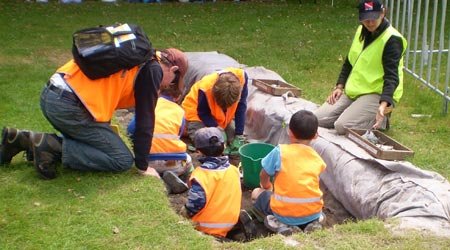By Helen Cronin, Master of Archaeology student. You can also read more of Helen’s work at her personal blog.
Portuguese archaeologist Leonor Medeiros’s contribution to the Day of Archaeology 2011 project was a lament.
I still feel tormented by the fact that, after you dig a site, and discover so much about it, that information is going to only a few people, and most of the sites are left to be destroyed or abandoned.
Her words echo my own feelings. The temporary exhibition I am working on as an intern will show Bendigo residents what was happening behind the fence two years ago before a new office building was constructed. But it is an unusual case. The archaeology associated with most development sites in Australia goes exactly the same way as Medeiros’s Portuguese sites. The consultant archaeologists write a report and hand it over to the developer or land owner. The artefacts disappear into a warehouse. The local paper might have carried a couple of stories about the excavation while it was happening, but that’s about it.
Archaeology for the sake of it
Why do we bother? It seems a pointless exercise to investigate archaeological sites simply for the sake of it. The Victorian Heritage Act 1995 (which does not apply to Aboriginal cultural heritage) only states that its purpose is:
to provide for the protection and conservation of places and objects of cultural heritage significance and the registration of such places and objects
It is not in the nature of legislation to question its own existence, but to what end are we protecting and conserving cultural heritage if no-one knows about it? Why excavate a site if the locals who would be most interested by dint of their connections to the place never hear the story of the site? What is the point of heritage if it doesn’t contribute to people’s sense of themselves as a part of a place because they know more of its history.
Contract archaeology is driven by funding imperatives. The developer funds the excavation reluctantly; the archaeologist must get the work done in a limited time frame and has no budget for the niceties of interpretation for a non-specialist audience. But just for a moment, put aside all those funding and resource constraints and imagine what archaeology with a purpose beyond fulfilling legislative requirements might look like.

Both kids and adults are fascinated by archaeology as the Port Arthur Kids Dig program demonstrates. Photo A. Kinsela
Imagine
-
There would be real community involvement.
Instead of peering through a cyclone wire fence as they walk past, people could volunteer to help – anyone from primary school kids to retirees. People are fascinated by archaeology. Getting your hands dirty is a great way to connect with your local history. And connecting with your local history generally means you’re more willing and interested in protecting and conserving it because it means something to you. (See the Council for British Archaeology, which welcomes volunteers, for example.) -
There would be broader and more direct communications.
Podcasts from the archaeologists, blog entries, Facebook pages, YouTube posts, Tweets, a display at the library or council offices. This would give a much better sense of how archaeology is done and how stories emerge and change as the work goes on. - The reports would contain at least a summary targetted at a non-specialist audience and copies would be lodged with the local library. (See Tales of the Vasco, for example which was part of a final report and tells stories about the site based on the archaeological evidence.)
Yes, it’s probably fanciful. But nothing really changes if you don’t have a vision first, does it?


There has been some interesting research that demonstrates the value of a methodologies that integrate principles from outside the discipline of archaeology (eg. cultural tourism, marketing). The African burial ground in New York is a great example of archaeology making significant contributions to community, cultural resources and to the general public. See also a thesis in the library on this issue ‘”The business of archaeology. Archaeology as a value added process” 1998. Rapita looks at the sites Turner’s Paddock and Burra etc and what alternatives there might be other than archaeology just for the sake of it. Unfortunately at the end of the day there is little scope, funding or incentive to do more than required and ultimately it is up to individual archaeologists to think more broadly than simply recording a series of details.